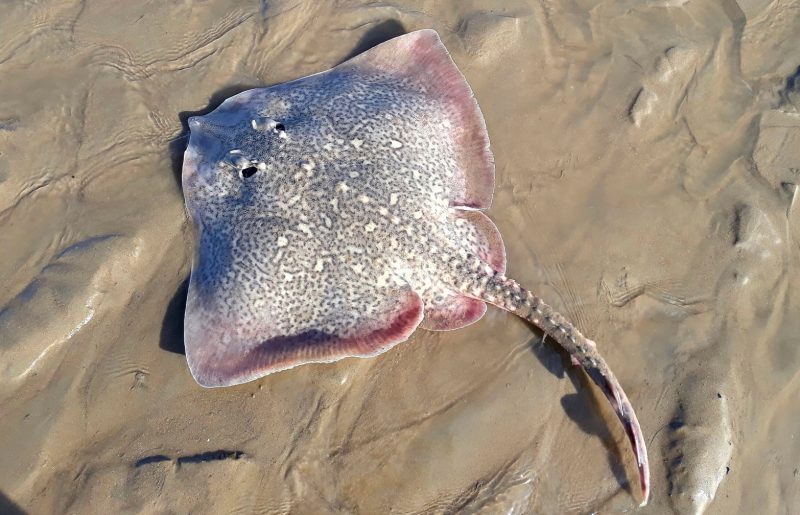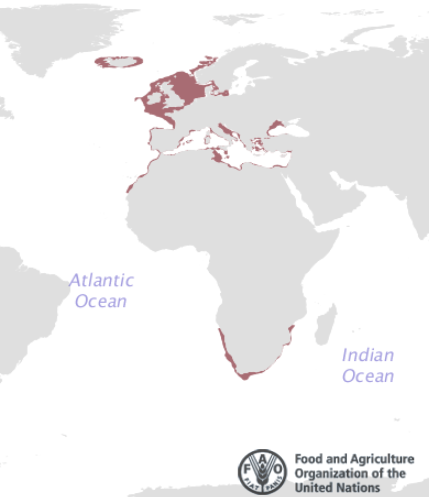Thornback Ray

Scientific name: Raja clavata
Also known as: Roker, skate (although not to be confused with Common Skate, Dipturus batis)
MCRS: None
Description
Rays are of the same family as sharks – the elasmobranchs. Thornbacks are a short snouted ray with a similar general shape as other rays with the pectoral fins at almost 90 degree angles joining head and body. They can be mottled brown-grey but are variable in colour with large numbers of dark spots and yellowish patches. Their underside is off-white with grey-black markings. On the dorsal side and on the tail there are a number of coarse prickles and large thorns (buckles). They increase in size and number as the animal ages and, in females, form a line along the back. They can grow up to 1m long but are usually around 85cm. Females grow to a larger size than males.
Habitat and Distribution

©FAO (Source Accessed 06/04/2018)
Thornback ray distribution ranges throughout the Eastern Atlantic from just south of the Arctic Circle to South Africa. They are also found in the Mediterranean and the Black Sea.
This bottom dwelling species is found over a variety of sediments including mud, shingle, gravel and sand but is more often recorded over finer sediments. They can inhabit a depth of up to 300m but are most commonly between 10-60m. They move offshore to deeper waters in the autumn and winter, and back to shallower inshore waters in spring.
Life Cycle, Reproduction and Feeding
Thornback rays predominantly feed on crustaceans, sand eels and small fish species. As a nocturnal species they feed at night and spend the hours of daylight partially buried in the sand. They tend to wait and ambush prey rather than actively hunt them.
Adult thornback rays spend the winter in deeper water, then migrate inshore to breed and lay eggs from May-September. Males reach sexual maturity earlier than females at around 7 years old; females at around 9 years old. The mating season occurs from February–September with a peak in June. Little is known about the mating behaviour of thornback rays; some believe it is because mating activity occurs at night. They lay up to 150 egg cases per year in sandy or muddy substrate. Each keratin case contains an egg surrounded with nutritious yolk which feeds the developing embryo. Development continues until a tiny ray breaks open the case and swims out into the sea. Empty egg cases, known as Mermaid’s Purses, can be found washed up on shores around the UK. Young hatch after 4-5 months, depending on water temperature, and are about 11-13 cm in length. Juveniles are non-migratory and inhabit inshore nursery grounds. Thornback ray are thought to have a life span of 15 years.
Additional Information
Thornback eggs are an important food source for some fish and juveniles are preyed upon by larger fish species and even adult thornbacks. Like other elasmobranchs they can detect weak electric fields from other organisms for both prey detection and predator avoidance.
In the NWIFCA District
Thornback rays are fished commercially in the District by both shore and boat based nets and through trawling. While they can be taken for human consumption thornbacks often have a lower commercial value than other target species. The majority of the ‘skate’ sold in fish and chip shops will be thornback ray. As such, they are often taken as bycatch. Historically, catches of thornback ray were recorded more generally under ‘skates and rays’; however since 2009 species-specific recording has been compulsory.
Thornback ray are a slow growing and slow maturing species and are therefore vulnerable to overfishing as stocks would take a long time to recover. They also form into shoals and so can be removed easily by trawls.
Thornback ray are popular with many shore anglers; while they usually remain in deep water throughout winter they migrate to shallow inshore waters, within an anglers range, in summer.
Fisheries Management
Within the district there are Byelaws to restrict the use and dimensions of nets and trawls. These vary in different location throughout the district. To read more about this click here.
Where commercial trawling and netting occurs in Marine Protected Areas it undergoes an assessment to ensure the activity does not cause risk to conservation features. HRAs carried out for trawling and netting in the District’s European Marine Sites can be found here.
There are also national and international measures that apply to this fishery, an annual total allowable catch (TAC) has been set for the skate and ray species encompassing thornback rays. TACs are divided up at an international level in the form of quotas and boats that are eligible are given a proportion of this quota and can fish for the species. Once the available quota has been fished the fishery is closed. To read more about this click here.